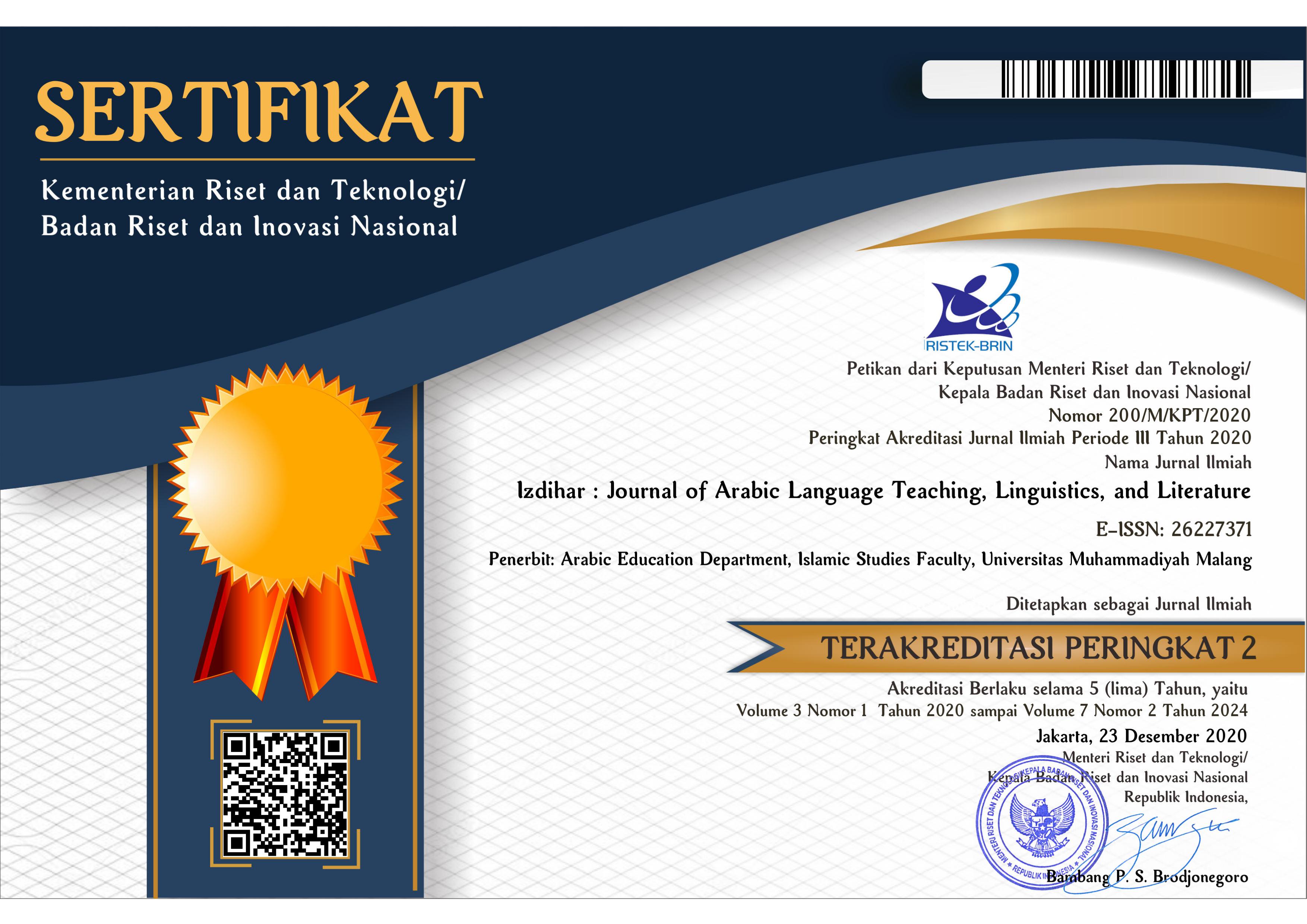Assessing Arabic Speaking Skills: A Critical Study for Implementation of Final Examination in Indonesia
DOI:
https://doi.org/10.22219/jiz.v5i2.22294Keywords:
Assessment, Arabic Speaking Skills, National School Final Examination/UAMBNAbstract
Assessment is one of the basic processes in the educational process after determining goals and teaching students. The national school final examination, in Indonesia called UAMBN, is one of the programs for conducting Arabic language tests, and focuses on assessing four skills of students. In fact, speaking skills test is not in the program. The purpose of this research is to criticize the lack of implementation of speaking skills assessment at UAMBN. Researcher used a critical methodology to analyze the data by configuration of four analytically distinguished but intertwined dimensions: (1) critical understanding and in-depth examination, (2) critical explanation and comparative generalization, (3) open discourse and transformative redefinition or action, and (4) reflexive–dialectic argumentation. The results of the study are the absence of an Arabic speaking skill test in the national madrasah final exam/UAMBN cannot be tolerated. Distributing the assessment process in national school final exams/USBN is not the right solution. UAMBN should still hold Arabic speaking skills tests in special sessions. The solution in the form of an assessment implementation design is available in this study. Further research related to the application of this design is highly recommended to improve the quality of learning Arabic speaking skills.
Downloads
References
Abdurrahman, M., Syihabuddin, Sopian, A., Maulani, H., & Faqih, A. (2021). Arabic language proficiency test efficiency and innovation on Imalah.com. Proceedings of the Fifth International Conference on Language, Literature, Culture, and Education (ICOLLITE 2021), 595(Icollite), 419–423. https://www.atlantis-press.com/proceedings/icollite-21/125963426
Ainin, M., Tohir, M., & Asrori, I. (2006). Evaluasi dalam pembelajaran bahasa Arab. Misykat.
Alam, S. M. (2004). Al Taqwim al tarbawiy al badil: Ususuh al nazariat wal manhajiat wa tatbiqatih al maydania. Dar al Fikr lil Tiba’ah wa al Nasyr wa al Tauzi’. https://books.google.co.id/books?id=mQFvQgAACAAJ
Ali Saad Al-Yaari, S., Saleh Al Hammadi, F., & Ayied Alyami, S. (2013). Evaluation of language testing: An applied linguistic perspective. International Journal of English Language Education, 1(2), 27–54. https://doi.org/10.5296/ijele.v1i2.3059
Bachman, L. F. (2013). Ongoing challenges in language assessment. The Companion to Language Assessment, November 2013, 1586–1604. https://doi.org/10.1002/9781118411360.wbcla128
POS USBN/Standard operating procedures for implementing national standard school exams, Pub. L. No. NOMOR: 0048/BSNP/XI/2018 (2018). https://ayomadrasah.blogspot.com/2018/12/download-pos-uambn-tahun-2018-2019.html?m=1
Bari, M. S. ’Abd al. (2010). Qawa’im al taqdir wa funun al lughati. Dar al Masirat lil Nashr wal Tawzi’ wal Tiba’a.
Budi, M. I. al. (2003). Al Hiwar-faniaatuh wa stiratijiaatuh wa asalib ta’limiatun. Maktabat wahba.
Cecez-Kecmanovic, D. (2014). Doing critical information systems research - arguments for a critical research methodology. European Journal of Information Systems, 20(July 2011), 440–445. https://doi.org/10.1057/ejis.2010.67
Clark, M. (2010). Arabic computerized assessment of proficiency ( Arabic CAP ) (Issue August). http://casls.uoregon.edu/papers.php
Cubbellotti, S. (n.d.). Examination Evaluation of the ACTFL OPI ® in French , Korean , Mandarin for the ACE Review Prepared for : American Council on the Teaching of Foreign Languages ( ACTFL ). https://www.google.com/url?sa=t&rct=j&q=&esrc=s&source=web&cd=&ved=2ahUKEwils6_Zn-f5AhVm5nMBHcJ3BuYQFnoECA8QAQ&url=https%3A%2F%2Fwww.languagetesting.com%2Fpub%2Fmedia%2Fwysiwyg%2Fresearch%2Freports%2FExamination_Evaluation_of_the_ACTFL_OPIc_in_Arabic_English_and_Spanish_for_the_ACE_Review.pdf&usg=AOvVaw0mu0NPI52dsJwki2VHsxEU
Daylmi, T. ’Aali H. al. (2003). Al Turuq al ’Amaliat fi tadris al lughat al ’arabia. Dar al Shuruq lil Nashr wal Tawzi’.
Djiwandono, S. (2011). Tes bahasa: Pegangan bagi pengajar bahasa (2nd ed.). Pt Indeks.
Fan, J., & Yan, X. (2020). Assessing speaking proficiency: A Narrative review of speaking assessment research within the argument-based validation framework. Frontiers in Psychology, 11(February), 1–14. https://doi.org/10.3389/fpsyg.2020.00330
Fathoni, A. (2020). Evaluasi program ujian akhir pada Madrasah Aliyah Makrifatul Ilmi Bengkulu Selatan. Jurnal Manajer Pendidikan, 14(3), 136–146. https://doi.org/doi.org/10.33369/mapen.v14i3.11749
Fu’ad, A. (1992). Al Maharat al lughawiatu: Mahiatuha wa tara’iq tadrisiha (2nd ed.). Mahfuzah lil Nasyr.
Gebril, A., & Taha-Thomure, H. (2013). Assessing Arabic. The Companion to Language Assessment, 1779–1789. https://doi.org/10.1002/9781118411360.wbcla065
Hamid, A. (2013). Mengukur kemampuan bahasa Arab. UIN MALIKI Press.
Iskandarwassid, & Sunendar, D. (2016). Strategi pembelajaran bahasa. Remaja Rosdakarya.
Khuli, M. A. al. (1989). Asalib tadris al Lughat al ’Arabiyat. Al Arabiyah al Sa’udiyah.
Kishon-rabin, L., & Rosenhouse, J. (2000). Development of speech assessment tests for Arabic-Speaking children. International Journal of Audiology, 39(5), 269–277. https://doi.org/doi/citedby/10.3109/00206090009073091?scroll=top&needAccess=true
Knight, B. (1992). Assessing speaking skills: A workshop for teacher development. ELT Journal, 46(3), 294–302. https://doi.org/10.1093/elt/46.3.294
Miller, M. D., Linn, R. L., & Gronlund, N. (2013). Measurement and assessment in teaching. Pearson. https://books.google.co.id/books?id=oxc_ngAACAAJ
Mutholib, A. (2013). Analisis butir soal bahasa Arab Ujian Akhir Madrasah Berstandar Nasional (UAMBN) bagi siswa Madrasah Ibtidaiyah (MI) tahun pelajaran 2012-2013. Arabia, 5(2), 141–161. https://doi.org/10.21043/arabia.v5i2.1387
Ounis, A. (2017). The assessment of speaking skills at the tertiary level. International Journal of English Linguistics, 7(4), 95. https://doi.org/10.5539/ijel.v7n4p95
Qodri, M. (2019). Arabic language test in the perspective of competency- based curriculum for students of Madrasah Aliyah Negeri 3 Malang. Izdihar Journal of Arabic Language Teaching Linguistics and Literature, 2(2), 115–134. https://doi.org/10.22219/jiz.v2i2.10003
Rakhlin, N. V., Aljughaiman, A., & Grigorenko, E. L. (2021). Assessing language development in Arabic: The Arabic language: Evaluation of function (ALEF). Applied Neuropsychology: Child, 10(1), 37–52. https://doi.org/10.1080/21622965.2019.1596113
Rammuny, R. M. (1992). Arabic proficiency test. https://www.academia.edu/32538158/The_New_Arabic_Proficiency_Test_Report
Ta’imat, R. A. (n.d.). Manahij tadris al lughat al ’arabiat bi al ta’lim al asasi. Dar al Fikr al ’Arabiy.
Wahab, A. G. S. A. (2020). Assessing language development in Arabic-learning [University of Plymouth]. https://www.researchgate.net/publication/342339465_Assessing_language_development_in_Arabic-learning_monolingual_and_bilingual_toddlers
Downloads
Published
How to Cite
Issue
Section
License
Copyright (c) 2022 Widiya Yul, Riko Andrian, Ahmad Musthofa, Jihan Fitri Rozianie, Izdihar : Journal of Arabic Language Teaching, Linguistics, and Literature

This work is licensed under a Creative Commons Attribution-ShareAlike 4.0 International License.
Copyright Notice
Authors who publish with this journal agree to the following terms:
- Authors retain copyright and grant the journal right of first publication with the work simultaneously licensed under a Creative Commons Attribution-ShareAlike 4.0 International License that allows others to share the work with an acknowledgment of the work's authorship and initial publication in this journal.
- Authors are able to enter into separate, additional contractual arrangements for the non-exclusive distribution of the journal's published version of the work (e.g., post it to an institutional repository or publish it in a book), with an acknowledgment of its initial publication in this journal.
- Authors are permitted and encouraged to post their work online (e.g., in institutional repositories or on their website) prior to and during the submission process, as it can lead to productive exchanges, as well as earlier and greater citation of published work (See The Effect of Open Access).
Copyright (c) 2019 Izdihar : Journal of Arabic Language Teaching, Linguistics, and Literature

This work is licensed under a Creative Commons Attribution-ShareAlike 4.0 International License.

















